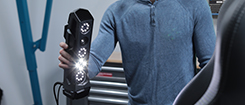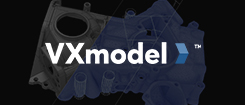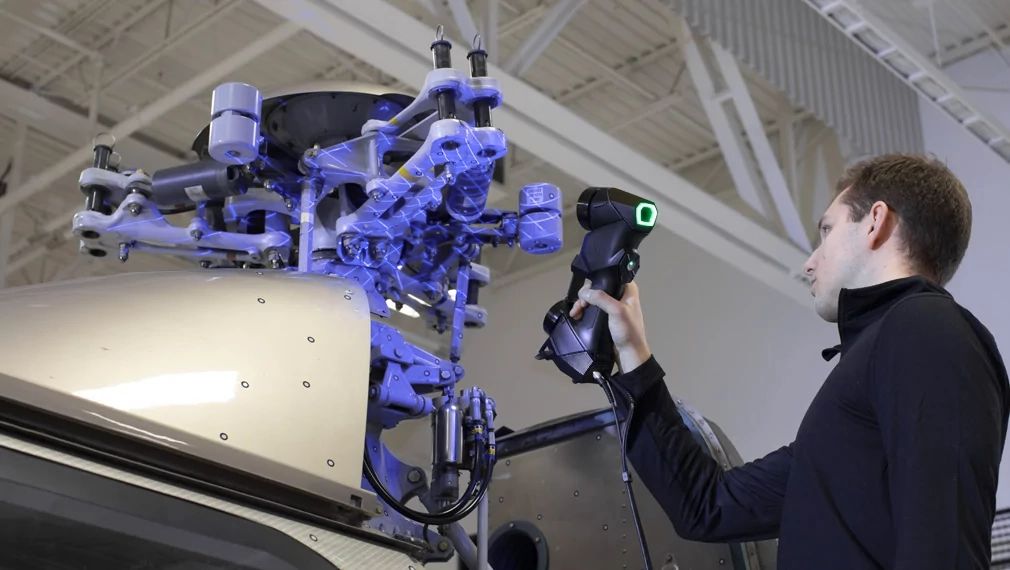July 24, 2024
Improving Vessel Integrity at a Refinery thanks to Advanced 3D Scanning Technology See the article3D scanning can be used to measure objects of art in order to assess their 3D dimensions accurately.
A multitude of old sea fossils, such as dinoflagellates (single-celled marine organisms), can be found in the soil of the Arabian Peninsula. Dinoflagellates are a subgroup of plankton that are responsible for a large portion of the oxygen in the atmosphere. They are also fundamental to the food pyramid. The Kuwaiti artist Monira Al Qadiri took inspiration from these dinoflagellates to create five larger-than-life Zephyr structures made from acrylic glass.
The German company Heinz Fritz GmbH supported her in this project. Heinz Fritz GmbH primarily manufactures transparent plastics, such as acrylic glass (PMMA) and polycarbonate (PC), but also provides products made from engineering plastics, such as POM, PE, PTFE, etc. The products they offer range from blank cutouts, milled parts, and molded and glued parts to complex modules and XXXL assemblies. Heinz Fritz GmbH predominantly acts as a supplier for a range of well-known companies within the engineering and lighting industry. However, the company also regularly supplies facade components to architects, pieces of art and sculptures to artists, and aquarium glass to zoos.
Data for the Milling Machine
The company uses high-precision 5-axis portal milling machines with a working area of up to 20 m x 5 m x 2.5 m. The STL data acquired with the 3D scanner and generated by the VXelements software can be processed directly with the CAD and CAM systems available at Heinz Fritz GmbH. Usually, parametric data serves as the basis for milling operations but, for very complex shapes, an additional scan offers increased productivity and production reliability. This makes it possible to connect the virtual world with reality with all the associated tolerances.
Before 3D measurement technology was used, the required data had to be determined with a probing method. The more complex the shape of a component, the more complex it is to determine all the required points. The Creaform 3D scanning system is currently helping the company generate 3D data, install components, and assess target and actual versions of manufactured components.
“We were looking for a solution that would not only simplify our work, but that would also increase accuracy. In this sense, the Creaform system impressed us with the accuracy it is able to achieve for larger components too. The deciding factor for us was the easy-to-use functionality of the VXelements software and the direct output in .stl format”, explains Mr. Jakob Sixl, Managing Partner at Heinz Fritz GmbH. “The intuitive operation of the 3D scanner and VXelements software allowed us to gain initial experience even before the training with a Creaform team member began. This meant that it was easy for us to get started and even work on concrete example cases and look at individual problems during the training phase.”
Producing Art from the Milling Machine
The artwork known as “Zephyr” consists of five acrylic glass sculptures that are lit from beneath in order to recreate the organisms’ bioluminescence. It is a permanent installation at West Beach Front in Doha. The project provides a 20,000x magnification of microscopic organisms, known as dinoflagellates, that are found in almost all bodies of water across the world. The sculptures aim to reveal the crucial role that small, invisible creatures have to play as well as to demonstrate the importance of sea life. ZEPHYR is also a colourful reminder of the history of the region’s ecosystem, and with it, the need to safeguard its longevity in the face of rapid modernization.
Heinz Fritz GmbH helped to create these sculptures. Based on 3D data provided by the artist, the high-precision 5-axis milling machine was used to mill the sculptures out of solid Plexiglas® blocks. For this, VXmodel software helped to process and optimize the data that was provided. The dimensions of the sculptures amount to 3.2 m x 2.4 m with a thickness of over 900 mm.
After the milling process, each sculpture was scanned using the Go!SCAN SPARK. “VXelements software was particularly useful for this as it significantly facilitated data processing and, thereby, enhanced our existing CAD and CAM systems,” says Mr. Sixl.
“Recently, it has become increasingly common to use 3D measurement technology as an almost go-to choice and we’re constantly finding new possibilities for the implementation of this technology. This primarily increases our quality standards, but it also increases productivity and production reliability too, often reducing working time. We’ve not yet explored all the possibilities that the 3D scanner offers, and I believe there’s more to come. We’re working hard to use 3D measurement technology to find new solutions to problems,” explains Herr Sixl.














